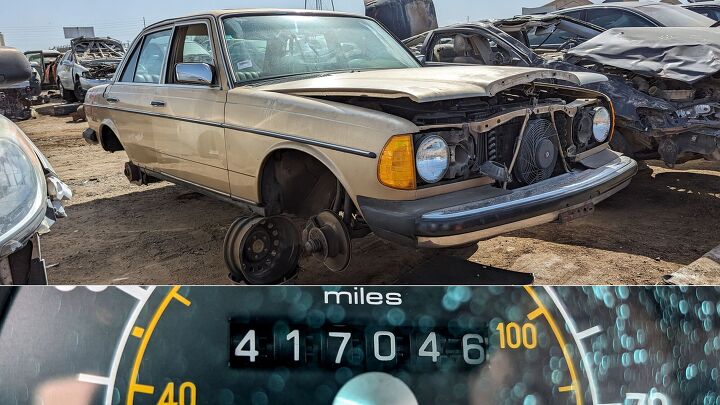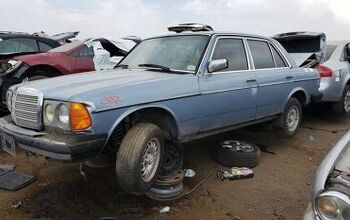Junkyard Find: 1982 Mercedes-Benz 300 D With 417k Miles

If you owned a car that had traveled more than 400,000 miles during its life, could you bear to send it into the cold steel jaws of The Crusher? In the course of my junkyard adventures, I've found quite a few vehicles that met such a fate. Here's a very solid Mercedes-Benz W123 oil-burner that now languishes in a self-service boneyard in Phoenix, Arizona.
417,046 miles is about the same as traveling 16-¾ times around Earth (using a great circle route, of course), and that distance is impressive even by Mercedes-Benz diesel standards.
417,046 miles is enough to get this car into 11th place in the Murilee Martin Junkyard Odometer standings. Remember that 1985 W123 with 411,448 miles we saw in a Denver car graveyard a few years back? That car has been pushed down to 16th in the MMJO list.
Don't worry about a lack of Stuttgart iron in the MMJO Top Ten, Mercedes-Benz fans, because there are three at the moment:
- 1990 Volvo 240, 631k miles
- 1988 Honda Accord, 626k miles
- 1987 Mercedes-Benz 190E, 601k miles
- 1981 Mercedes-Benz 300 SD, 572k miles
- 1985 Mercedes-Benz 300 SD, 535k miles
- 1988 Honda Accord, 513k miles
- 1990 Volvo 740 Turbo, 493k miles
- 1990 Nissan Sentra, 440k miles
- 1991 Honda Accord, 435k miles
- 1996 Honda Civic, 435k miles
For those keeping nationalistic score, that's two cars built in Sweden, three built in West Germany, three built in the United States (the Sentra and the pair of 1990s Hondas), and two built in Japan. I'm sure there would be more Mercedes-Benzes on the list if junkyard shoppers didn't buy most W123 and W126 gauge clusters within days of hitting the yards, and more American-marque machinery if Detroit hadn't stuck with five-digit odometers until well into the 1990s.
Here's the legendary OM617 five-cylinder turbodiesel engine that got the job done so well. A junkyard customer showed up to extract the injectors while I was admiring this car.
This one was rated at 120 horsepower and 170 pound-feet, which wasn't a lot for a car scaling in at 3,585 pounds (fun fact: the current C-Class weighs quite a bit more than 1982's proto-E-Class). However, its naturally-aspirated sibling, the legendarily slow 240 D, had just 67 horses and 97 pound-feet.
American Mercedes-Benz shoppers in 1982 could get the 240 D with a four-on-the-floor manual transmission, but a four-speed automatic was mandatory on the U.S.-market 300 D.
It appears that the first chapters of this car's life took place on the roads of Southern California. Amato's Auto Body is still in the same location in San Diego shown on this sticker; the seven-digit telephone number suggests that the sticker is of 1990s or earlier vintage.
The sticker from Heinz Geitz's repair shop in La Jolla led me to a lot of interesting tales of the life and career of Herr Geitz (who passed away in 2017 at the age of 97). After spending most of World War II in a Soviet POW camp, he emigrated to the United States and took a job working for Mercedes-Benz here. In 1956, he became crew chief for Augie Pabst (yes, from that Pabst family), then migrated to La Jolla during the 1960s. His grandson founded HG Performance, a Mercedes-Benz tuner shop in San Marcos, that exists to the present day. You'll find plenty of history in the junkyard if you dig a little bit!
Cars that live near the Pacific in California can get some terrifying top-down rust from salt spray mixed with morning fog, but this car has just a touch of corrosion around the rear wheelwells from rainwater leakage past the trunk's weatherstripping.
The interior appears to have been in nice condition before junkyard shoppers bought most of the door panels and seats.
MB-Tex fake leather is amazing stuff. Ordinary upholstery would have been nuked into powder by four decades in the climate of San Diego and Phoenix.
In the end, even the BVM couldn't save this car from its junkyard fate.
The timing of the turbocharger-toting technician walking the banked oval worked out well for everyone involved in this commercial.
1982 Mercedes-Benz 300 D W123 in Arizona wrecking yard.
1982 Mercedes-Benz 300 D W123 in Arizona wrecking yard.
1982 Mercedes-Benz 300 D W123 in Arizona wrecking yard.
1982 Mercedes-Benz 300 D W123 in Arizona wrecking yard.
1982 Mercedes-Benz 300 D W123 in Arizona wrecking yard.
1982 Mercedes-Benz 300 D W123 in Arizona wrecking yard.
1982 Mercedes-Benz 300 D W123 in Arizona wrecking yard.
1982 Mercedes-Benz 300 D W123 in Arizona wrecking yard.
[Images: The author]
Become a TTAC insider. Get the latest news, features, TTAC takes, and everything else that gets to the truth about cars first by subscribing to our newsletter.

Murilee Martin is the pen name of Phil Greden, a writer who has lived in Minnesota, California, Georgia and (now) Colorado. He has toiled at copywriting, technical writing, junkmail writing, fiction writing and now automotive writing. He has owned many terrible vehicles and some good ones. He spends a great deal of time in self-service junkyards. These days, he writes for publications including Autoweek, Autoblog, Hagerty, The Truth About Cars and Capital One.
More by Murilee Martin
Latest Car Reviews
Read moreLatest Product Reviews
Read moreRecent Comments
- Lou_BC Actuality a very reasonable question.
- Lou_BC Peak rocket esthetic in those taillights (last photo)
- Lou_BC A pickup for most people would be a safe used car bet. Hard use/ abuse is relatively easy to spot and most people do not come close to using their full capabilities.
- Lorenzo People don't want EVs, they want inexpensive vehicles. EVs are not that. To paraphrase the philosopher Yogi Berra: If people don't wanna buy 'em, how you gonna stop 'em?
- Ras815 Ok, you weren't kidding. That rear pillar window trick is freakin' awesome. Even in 2024.





















































Comments
Join the conversation
Some thoughts.
All cars from this era appear to us as being mechanically simple and thus easy to work on. I think for the most part this is true, even on W123s which despite this were a little more complicated than your average 1970s car. These things are all over Africa and the Middle East, still soldiering on after their odometers stopped working at 999,999 km 20 years ago - literally. But the folks there know how to work on these and have also developed their own tools or spares to keep them running. There’s a great documentary on Youtube in German called “Autos für die Ewigkeit” and it’s mainly about old Mercedes cars and trucks in South America, Africa and the Middle East with hundreds of thousands of kilometers or in many cases over a million kilometers behind them (some trucks in Brazil had something like 4.3 million kilometers on his 1960s Mercedes Kurzhauber truck) and was still using it as a daily truck. What I found fascinating about this documentary is that it showed the people in these regions creating their own tools for maintenance or creating a spare parts in some backyard mechanic shop. Fascinating!
I disagree with the claim that modern cars are built to “last the length of the lease”. In my experience modern cars are actually much better made than older cars. The old-school “solid door shut feel” of Mercedes’ was in my experience not unique to them. Old cars are heavy and usually had thicker doors as a form of safety I suppose. Modern cars are all about lightweight construction to save weight and improve fuel economy. A 1972-1980 Mercedes W116 S-Class had doors which shut and felt like a bank vault. It’s successor, the 1979-1993 W126 S-Class was put on a diet and had weight reduction wherever possible and as a consequence its doors didn’t shut with that “bank vault” thud feel. The same applies to the W123’s successor, the W124, which was lightened and thus didn’t feel as solid as a W123. Doesn’t mean the car was built to a lesser standard.
I think the fact that some people lease cars gives them a bad reputation in the first place. Think about it. Someone leasing a car isn’t necessarily going to treat it right or abide by maintenance schedules. Why should they? They don’t care about the future of this car or the second owner when they will lease the facelifted or new model after three years. I’ve ridden with people who gunned their leased car with a cold engine and abused it - stuff like that is gonna damage the engine over time if this is repetitive behavior. A modern car with proper treatment from the owner will be just as reliable if not more so than an older car. I don’t even think most owners of modern turbo cars know how to treat them properly: drive them warm, drive them cold and they should be fine.
I’ve treated all my German cars well and never had any serious mechanical issues or problems that would make me call them unreliable. I also don’t think that electronics these days are going to be a big problem overall. Technology evolves and gets better. Electronics might have been a weakspot on most cars in the late 1990s and early 200s, but these days manufacturers or better yet their suppliers have gotten these things perfected to the point where they will remain functional and reliable for decades. Hell, I am typing this on a 16-year-old laptop which has never had an issue and while slow[er] than before, it still works, graphics card etc. all work fine.
When I saw the pic of that diesel engine I paused to put my hand over my heart. What a masterpiece of an engine, and I don't care if it IS slow. And then, the comment about the MB-tex had me doing the same thing. Mercedes has achieved quite a few levels of greatness over the years.